The history of wind energy
The history of wind energy: from its origins to modern sustainability
From windmills for grinding grain or moving water to modern turbines with blades more than 100 metres long, wind energy has evolved to become the renewable energy with the most installed capacity in the world.
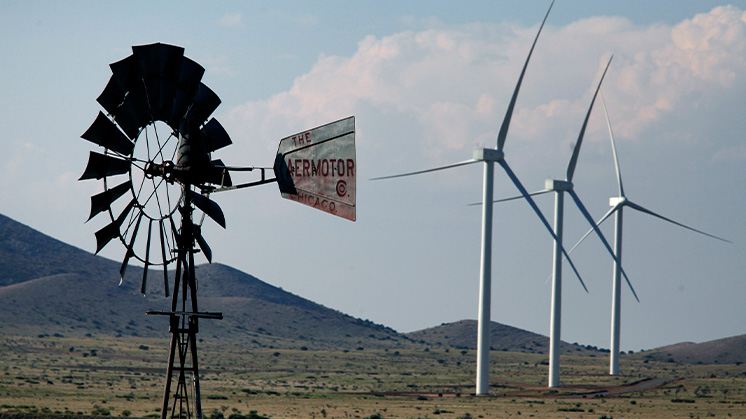
Onshore wind energy is one of the most widely used forms of renewable energy on the planet and consists of harnessing the power of the wind by means of wind turbines to generate electricity. These wind turbines placed in strategic locations have enormous blades that capture the kinetic energy of the wind, making them rotate. This movement is transferred to a generator that converts the mechanical energy to electricity, which is then fed to the grid for distribution and use.
But how did wind energy come about? The truth is that wind energy is, along with thermal energy, one of the oldest types of power in existence. Just think of ships sailing thanks to the wind or windmills used to grind wheat or pump water.
Origins and early uses of wind energy
The origins of onshore wind energy date back thousands of years. The first reference to the use of a windmill is to move the bellows of an organ, but it was in the 7th century when windmills began to be used in ancient Persia to grind grain and pump water. These mills were rigid, with a vertical wooden structure and six or eight blades covered with cloth. The blades were connected to a central shaft which, in turn, was coupled to a grinding stone or pumping mechanism that, when the wind blew and the blades of the mill began to rotate, picked up the movement and activated the desired mechanism, whether it was grinding grain to make flour or pumping water from wells or ponds.
Starting in the 11th century, when windmills began to be seen and popularised in Europe, their mechanism was perfected with orientation and regulation systems with rotating heads which, as they could be turned to the direction of the wind, were much more efficient. And it was in the mid-19th century that this technology made the leap to America, with the appearance of the American multi-bladed mill that was used to pump water from underground wells, especially on the Great Plains. Unlike European mills with their single rotor with a horizontal axis, American multi-bladed mills had a vertical axis with multiple blades. These blades were shorter and arranged vertically and could capture the wind from any direction. This made these mills more efficient in areas where the winds were changeable. This is the origin story of today's wind generators.
Advances and modernisation of wind energy: from windmills to turbines
The advancement and modernisation of wind energy from the old windmills to the modern wind turbines that exist today has been truly remarkable. First came the transition from vertical to horizontal axis windmill designs, which were more efficient and versatile in capturing wind energy, and then came the wind turbines that would take an exponential leap in terms of large-scale electricity generation.
The first wind turbine was the work of Charles F. Brush who, at the end of the 19th century, built one in Cleveland in the United States that, with a diameter of more than 17 metres, powered the lights not only in his mansion but also in several others, thus becoming one of the first applications of wind energy to generate electricity on a large scale.
Since then, there has been major progress in wind turbine technology with significant improvements terms of size, efficiency and reliability. Today, modern wind turbines use longer, more aerodynamic blades and advanced control systems that allow them to capture more energy from the wind and operate more efficiently in a wider range of weather conditions.
The world's first onshore wind farm: towards 2000
Through a partnership between NASA and the US Department of Energy, Towards 2000, the world's first onshore wind farm, was commissioned in 1981. Located on Crotched Mountain in New Hampshire, it consisted of four 15 kilowatt wind turbines, for a total capacity of 60 kilowatts.
The main objective of Towards 2000 was to demonstrate the technical and economic feasibility of wind energy for large-scale electricity generation. It also sought to raise awareness about the importance of renewable energy and its potential to reduce dependence on fossil fuels and mitigate climate change. Despite its modest size, especially compared to today's wind farms, it was a milestone and its success paved the way for the growth and expansion of the wind industry in the following decades.

Do you know how wind farms work?
We show you how we generate the wind power.
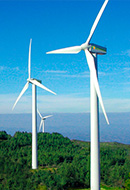
What is a wind turbine and how does it work?
This is the nature of wind turbines, the giants of renewable energy.
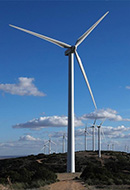
The most relevant terms in onshore wind energy
We propose some relevant terms to understand how wind energy works.
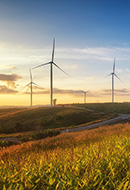
Wind measurement for wind farm
We tell you about the latest technological developments in this area.
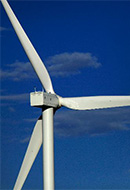
Wind blade recycling
The recycling of wind turbine blades, one of the key challenges for the industry.
Wind energy in the 21st century: major innovations in turbine technology and materials
Wind energy had already shown its enormous potential in the 20th century, but this has only been realised in the 21st century. The efficiency of modern turbines, the development of energy storage systems and grid integration technologies that allow better management of the inherent intermittency of wind energy have contributed to increasing its penetration in electricity grids and its more effective integration with other renewable and conventional energy sources. All this, together with the depletion of fossil fuels and a greater concern for sustainability, has meant that the 21st century has seen the greatest growth in onshore wind energy in the world.
Technological improvements in wind turbines are driving significant advances and enabling the move to higher power turbines with aspects such as the incorporation of advanced high-strength composite materials that allow blades to be both longer and lighter, so turbines can operate over a wider range of wind speeds and maximise the energy captured. This is combined with new advances in nanotechnology that make it possible to make materials that are more resistant to corrosion, with less wear & tear and that are better suited to adverse weather conditions, as well as the development of larger and more reliable components.
The integration of intelligence and connectivity into modern turbines is transforming the way they are managed and operated. Equipped with sensors and AI systems, these turbines monitor their performance in real time, predict maintenance needs and adapt their operation to wind conditions. This connectivity and predictive capability improves efficiency and extends wind installations’ useful lives.
Even more sustainable wind power: recycling blades and using second-hand materials
According to WindEurope, by 2030 approximately 5,700 wind turbines will be dismantled every year in Europe either because they have reached the end of their useful life or because of the repowering of wind farms. Blade recycling then has become a topic of growing interest in the industry due to the need to sustainably manage materials at the end of a wind farm's service life.
Turbine blades are mainly made of composite materials, such as fibreglass and resins, which makes recycling them a technical challenge. Even so, an estimated 83% of the material in a wind turbine can be recycled or reused.
At Iberdrola España we are determined that no blade should end up in a landfill. Together with FCC Ámbito, we set up the company EnergyLOOP, which will start up the first blade recycling plant in Spain. This plant will be in the south of Navarre, an area well connected to areas where wind energy is abundant, and will be the first of its kind on an industrial scale in Europe.
We also contribute to the reuse of components such as gearboxes, generators, transformers and blades, which we have been installing in some of our wind farms since 2022. These parts meet the highest quality standards and are for installations that are more than 15 years old. In this way, we extend the useful life of our oldest wind turbines in the most sustainable way possible.
Our onshore wind energy projects
At Iberdrola España, we are a global benchmark in onshore wind energy, with more than 20,600 MW of installed capacity worldwide, in which we continue to invest 28% of our investment in renewables. Our most emblematic facilities in this technology include: Oitis, our largest onshore wind project in Latin America; El Cabo, a flagship facility in the United States; Cavar, the largest wind facility built by Iberdrola España in Spain in recent years; and Port Augusta, Australia our first hybrid wind and solar facility in the world.




